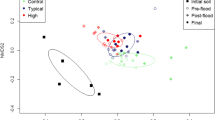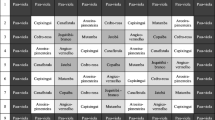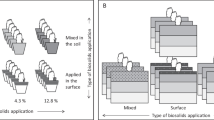Abstract
A plot study was conducted to quantify long-term (>12 years) impacts of a single biosolids application, and short-term impacts (<2 years) of a repeated application, on semi-arid rangeland soil chemical and microbial parameters. In 2003 and 2004, plots which had received 0, 2.5, 5, 10, 21, or 30 Mg biosolids ha−1 once in 1991 (long-term plots), or again in 2002 (short-term plots), were sampled and analyzed for soil chemical parameters, microbial biovolumes, C and N mineralization activities, Biolog EcoPlate substrate utilization potential, and plant productivity and tissue quality. Repeated applications temporarily exacerbated differences in soil chemical properties among treatments, but after 2 years, soil chemistry trends were similar between short-term and long-term plots. Soils which received a repeated application of 21 or 30 Mg biosolids ha−1 had greater bacterial biovolumes and C and N mineralization activities. In long-term plots, mineralization activities were stimulated only at the highest rate. Biosolids-amended soil communities also utilized Biolog substrates more quickly compared to communities from control plots. Plant biomass increased, whereas plant diversity and plant C/N ratio decreased with increasing application rate for both short- and long-term plots. Infrequent biosolids application had positive ecosystem effects in terms of site management objectives, with relatively low extractable metal levels in soil and greater plant biomass and tissue quality despite reduced species richness.

Similar content being viewed by others
References
Barbarick KA, Workman SM (1987) NH4–HCO3–DTPA and DTPA extractions of sludge-amended soils. J Environ Qual 16:125–130
Barbarick KA, Doxtader KG, Redente EF, Brobst RB (2004) Biosolids effects on microbial activity in shrubland and grassland soils. Soil Sci 169:176–187
Bloem J, Bolhuis PR, Veninga MR, Wieringa J (1995) Microscopic methods for counting bacteria and fungi in soil. In: Alef K, Nannipieri P (eds) Methods in applied soil microbiology and biochemistry. Academic, San Diego, CA, pp 162–173
Brandt RC, Elliott HA, O'Connor GA (2004) Water-extractable phosphorus in biosolids: implications for land-based recycling. Water Environ Res 76:121–129
Bremner JM (1996) Nitrogen—total. In: Sparks DL (ed) Methods of soil analysis, part 3. Chemical methods. SSSA, Madison, WI, pp 1085–1121
Choi K, Dobbs FC (1999) Comparison of two kinds of Biolog microplates (GN and ECO) in their ability to distinguish among aquatic microbial communities. J Microbiol Methods 36:203–213
Coleman DC, Crossley DA Jr (1996) Fundamentals of soil ecology. Academic, Amsterdam
Cuevas G, Blázquez R, Martinez F, Walter I (2000) Composted MSW effects on soil properties and native vegetation in a degraded semi-arid shrubland. Compost Sci Util 8:303–309
Dennis GL, Fresquez PR (1989) The soil microbial community in a sewage-sludge-amended semi-arid grassland. Biol Fertil Soils 7:310–317
Fresquez PR, Aguilar R, Francis RE, Aldon EF (1991) Heavy metal uptake by blue grama growing in a degraded semi-arid soil amended with sewage sludge. Water Air Soil Pollut 57/58:903–912
García-Gil JC, Plaza C, Senesi N, Brunetti G (2004) Effects of sewage sludge amendment on humic acids and microbiological properties of a semi-arid Mediterranean soil. Biol Fertil Soils 39:320–328
Harris-Pierce RL (1994) The effects of biosolids application on native rangeland soils and vegetation. MS Thesis, Colorado State University, Fort Collins
Klein DA, Paschke MW (2000) A soil microbial community structural–functional index: the microscopy-based total/active/active fungal/bacterial (TA/AFB) biovolumes ratio. Appl Soil Ecol 14:257–268
Konopka A, Oliver L, Turco RF Jr (1998) The use of carbon substrate utilization patterns in environmental and ecological microbiology. Microb Ecol 35:103–115
Lodge DJ, Ingham ER (1991) A comparison of agar film techniques for estimating fungal biovolumes in litter and soil. Agric Ecosyst Environ 34:131–144
Loftin SR, Aguilar R, Fresquez PR (1995) Rangeland restoration with surface-applied biosolids: effects on soils and vegetation of the Rio Puerco Watershed, Northcentral New Mexico. In: Proceedings: the effect of land application of biosolids in arid and semi-arid environments, Colorado State University, 16–19 May
Mulvaney RL (1996) Nitrogen-inorganic forms. In: Sparks DL (ed) Methods of soil analysis, part 3. Chemical methods. SSSA, Madison, WI, pp 1123–1184
Myrold D (2004) Transformations of nitrogen. In: Sylvia DM, Fuhrmann JJ, Hartel PG, Zuberer DA (eds) Principles and applications of soil microbiology. Prentice Hall, Upper Saddle River, NJ, pp 333–372
National Oceanic and Atmospheric Administration (2002–2004) Annual climatological summary, station 053006/99999. NOAA, Asheville, NC. Available at http://www ncdc.noaa.gov/onlinestore.html. Cited 20 Dec 2004
Nelson DW, Sommers LE (1996) Total carbon, organic carbon, and organic matter. In: Sparks DL (ed) Methods of soil analysis, part 3. Chemical methods. SSSA, Madison, WI, pp 975–977
Pascual JA, García C, Hernandez T (1999) Lasting microbiological and biochemical effects of the addition of municipal solid waste to an arid soil. Biol Fertil Soils 30:1–6
Porazinska DL, Bardett RD, Blaauw MB, Hunt HW, Parsons AN, Seastedt TR, Wall DH (2003) Relationships at the aboveground–belowground interface: plants, soil biota, and soil processes. Ecol Monogr 73:377–395
Reynolds HL, Packer A, Bever JD, Clay K (2003) Grassroots ecology: plant–microbe–soil interactions as drivers of plant community structure and dynamics. Ecology 84:2281–2291
Rhoades JD (1996) Salinity: electrical conductivity and total dissolved solids. In: Sparks DL (ed) Methods of soil analysis, part 3. Chemical methods. SSSA, Madison, WI, pp 417–435
SAS Institute, Inc. (2002) SAS/STAT user's guide, version 9.1. The SAS Institute, Cary, NC
Schutter M, Dick R (2001) Shifts in substrate utilization potential and structure of soil microbial communities in response to carbon substrates. Soil Biol Biochem 33:1481–1491
Sharkoff JL, Waskom RM, Davis JG (2003) Colorado phosphorus index risk assessment. Colorado agronomy technical note no. 95. USDA-NRCS, Lakewood, CO
Soil Conservation Service and Forest Service (1980) Soil survey of Larimer country area, CO. USDA, Lakewood, CO
Soltanpour PN, Johnson GW, Workman SM, Jones JB Jr, Miller RO (1996) Inductively coupled plasma emission spectrometry and inductively coupled plasma-mass spectrometry. In: Sparks DL (ed) Methods of soil analysis, part 3. Chemical methods. SSSA, Madison, WI, pp 91–139
Thomas GW (1996) Soil pH and soil acidity. In: Sparks DL (ed) Methods of soil analysis, part 3. Chemical methods. SSSA, Madison, WI, pp 475–490
US Environmental Protection Agency (1991) Interagency policy on beneficial use of municipal sewage sludge on federal land; notice. Fed Regist 56(127):30448–30450
US Environmental Protection Agency (1993) 40 CFR-Parts 257 and 503. Standards for the use and disposal of sewage sludge; final rule. Fed Regist 58(32):9248–9415
US Environmental Protection Agency Region 8 (1999) Biosolids management handbook, section 2. Available at http://www.epa.gov/region8/water/wastewater/biohome/biosolidsdown/handbook/handbook.html. Cited 11 May 2005
Wardle DA, Lavelle P (1997) Linkages between soil biota, plant litter quality and decomposition. In: Cadisch G, Giller KE (eds) Driven by nature—plant litter quality and decomposition. CAB International, Wallingford, UK, pp 107–124
Weinbauer MG, Backmann C, Höfle MG (1998) Utility of green fluorescent nucleic acid dyes and aluminum oxide membrane filters for rapid epifluorescence enumeration of soil and sediment bacteria. Appl Environ Microbiol 64:5000–5003
Acknowledgements
This research was supported by grant no. CP988640-01 from the Environmental Protection Agency, Region 8.
Author information
Authors and Affiliations
Corresponding author
Rights and permissions
About this article
Cite this article
Sullivan, T.S., Stromberger, M.E., Paschke, M.W. et al. Long-term impacts of infrequent biosolids applications on chemical and microbial properties of a semi-arid rangeland soil. Biol Fertil Soils 42, 258–266 (2006). https://doi.org/10.1007/s00374-005-0023-z
Received:
Revised:
Accepted:
Published:
Issue Date:
DOI: https://doi.org/10.1007/s00374-005-0023-z




